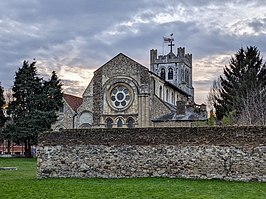| Waltham Abbey | |
|---|---|
|
Clockwise from top: Waltham Abbey Church and ruins, the Royal Gunpowder Mills, pedestrianised Sun Street, the Welsh Harp public house, and Waltham Abbey Town Hall | |
 Coat of arms of Waltham Abbey | |
| Area | 16.3746 sq mi (42.410 km2) |
| Population | 22,859 (2021 census)[1] |
| • Density | 1,396/sq mi (539/km2) |
| OS grid reference | TL385005 |
| • Charing Cross | 14 mi (23 km) SW |
| Civil parish |
|
| District | |
| Shire county | |
| Region | |
| Country | England |
| Sovereign state | United Kingdom |
| Post town | WALTHAM ABBEY |
| Postcode district | EN9 |
| Post town | LONDON |
| Postcode district | E4 |
| Post town | LOUGHTON |
| Postcode district | IG10 |
| Dialling code | 01992 020 |
| UK Parliament | |
Waltham Abbey is a suburban town and civil parish in the Epping Forest District of Essex, within the metropolitan and urban area of London, England, 13.5 miles (21.7 km) north-east of Charing Cross. It lies on the Greenwich Meridian, between the River Lea in the west and Epping Forest in the east, with large sections forming part of the Metropolitan Green Belt.
The town borders Chingford to the south; Loughton, Theydon Bois and Buckhurst Hill to the east; Cheshunt, Waltham Cross and Enfield to the west; and the rural areas of Nazeing and Epping Upland to the north. As well as the main built-up area, the parish covers the areas of Claverhambury, Fishers Green, High Beach, Holyfield, Lippitts Hill, Sewardstone, Sewardstonebury and Upshire. As of the 2021 census, the civil parish of Waltham Abbey had a population of 22,859.
The town is named and renowned for its former abbey, the last in England to be dissolved, now the Abbey Church of Waltham Holy Cross and St Lawrence—a scheduled ancient monument and the town's parish church. A place of worship since the 7th century, it became a place of pilgrimage following the Legend of the Holy Cross in the 11th century, and was rebuilt and re-founded by King Harold Godwinson, the last Anglo-Saxon king of England, in 1060. It is believed to be Harold's final resting place after his death at the Battle of Hastings in 1066. Open to the public as Waltham Abbey Gardens, the grounds of the abbey and Cornmill Meadows are maintained by the Lee Valley Regional Park Authority.[2] Along the town's eastern edge is much of Epping Forest, maintained by the City of London Corporation; entirely within it is the village of High Beach. In the south is Gilwell Park, which since 1919 has formed an important site for the worldwide Scout movement.[3] Following the course of the River Lea along the town's western boundary with Hertfordshire and historic Middlesex is the Lee Valley Regional Park, where the Lee Valley White Water Centre hosted the canoe slalom events of the London 2012 Olympic Games. For over 300 years, the Royal Gunpowder Mills on the Millhead Stream were in operation, where many of the processes used in the explosives industry were invented and developed;[4] it today forms a scheduled ancient monument site with many listed buildings, and is a site of special scientific interest.[5]
Historically an ancient parish named Waltham Holy Cross in the Waltham hundred of Essex, it became a local government district in 1850, and was granted urban district status in 1894. The town was granted a charter to host a regular market by Richard I in 1189, and it remains a market town. Whilst the use of the name Waltham Abbey for the town dates back to the 16th century at the earliest, it never officially had that name until 1974, when the successor parish covering the former Waltham Holy Cross Urban District was named Waltham Abbey. It was included in the Metropolitan Police District in 1840, and the London postal district upon its inception in 1856. It formed part of the review area for the Royal Commission on Local Government in Greater London, but did not become part of the Greater London administrative area in 1965. Its administrative headquarters have been at Waltham Abbey Town Hall since 1904. The town most likely gives its name to the American city of Waltham in Middlesex County, Massachusetts,[6] and is twinned with the German town of Hörstel.
- ^ "Waltham Abbey parish". City Population. Retrieved 30 September 2023.
- ^ "Waltham Abbey Gardens | Lee Valley Regional Park". Visit Lee Valley. Retrieved 21 October 2023.
- ^ "Gilwell Park 1919 – 2019 – heritage.scouts.org.uk". Archived from the original on 23 April 2023. Retrieved 21 October 2023.
- ^ "Waltham Abbey Royal Gunpowder Factory, Waltham Abbey - 1016618 | Historic England". historicengland.org.uk. Retrieved 21 October 2023.
- ^ "The Royal Gunpowder Mills - Waltham Abbey". Waltham Abbey. Retrieved 21 October 2023.
- ^ Nelson, Charles A. (1882). Waltham, Past and Present; and Its Industries. Cambridge, MA: Moses King. p. 66. Retrieved 25 June 2023.





